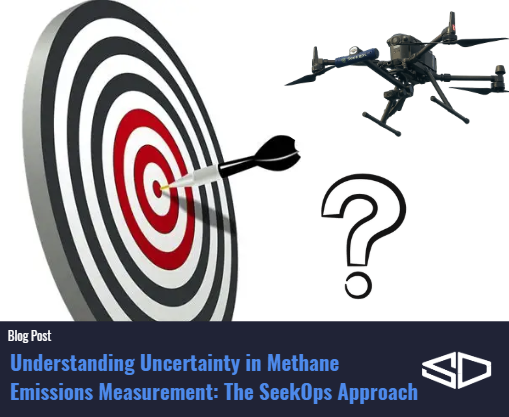Emissions data is only useful if you know how reliable it is. Here’s how SeekOps evaluates and improves confidence in methane measurements.
Read time: 5 minutes
Why Uncertainty Matters in Emissions Monitoring
In the world of methane detection and quantification, accuracy is only half the story. Just as important, is knowing how confident you can be in your results, and that’s where uncertainty comes in.
Uncertainty isn’t a flaw in a measurement; it’s an attribute necessary for measurement transparency. In any real-world measurement, especially in a dynamic outdoor environment, there’s always going to be a degree of uncertainty. At SeekOps, we take uncertainty seriously because it gives regulators, operators, and stakeholders a clear picture of how reliable an emissions estimate really is. It builds trust, enables better decision-making, and supports compliance with high-integrity reporting frameworks like OGMP 2.0 and other global methane standards.
In short, when the stakes are high, vague numbers aren’t enough. SeekOps reports how confident we are in those results. It’s data you can act on, with confidence grounded in precision.
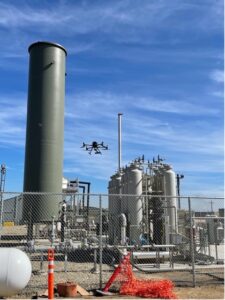
What Is Measurement Uncertainty?
Measurement uncertainty is a calculated estimate of how much the actual value could differ from the reported result. In simple terms, it’s our way of saying:
“Here’s the number—and here’s how sure we are.”
As stated above, uncertainty is not an error or a flaw. It’s a necessary part of scientific honesty and provides context to any measured value.
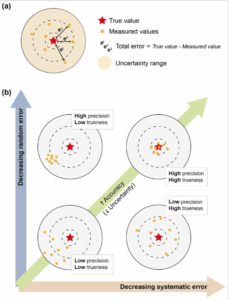
What Causes Measurement Uncertainty?
There are several factors that contribute to uncertainty in all top-down emissions measurements (e.g. drone, aircraft, satellite, continuous, etc.), including:
Sensor sensitivity and precision
How precisely can methane concentrations be measured, especially at low levels? Sensitivity and calibration factors extend to the sensors measuring wind, temperature, pressure, and position.Environmental conditions
Wind speed and direction, turbulence, temperature, and humidity can all affect how plumes behave.Plume geometry and flight path
Complex terrain or poorly optimized flight paths can miss parts of the plume or cause the measured concentrations to be artificially lowered.Background methane levels
Differentiating the source signal from regional background can be challenging.Model assumptions
Any model-based approach requires assumptions about wind fields, dispersion, or boundary conditions which all carry their own uncertainties. However, SeekOps only utilizes a small number of assumptions due to our rigorous mass-balance approach.
SeekOps acknowledges and quantifies all of these to provide a realistic, statistically grounded picture of methane emissions.
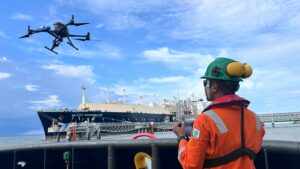
How SeekOps Quantifies and Reduces Uncertainty
SeekOps applies a rigorous process when evaluating uncertainty in methane emissions measurements. Thanks to our ability to detect leaks as small as 0.02 kg/h, we can reliably observe virtually all measurable emission enhancements in the field. This exceptional sensitivity means that a probability of detection (PoD), a common industry metric, does not meaningfully apply, as our detection rate is effectively 100% (Ravikumar et al., 2019).
Instead of stopping at “we detected it,” we focus on how confident we are in the measured emission rate. That means identifying, quantifying, and transparently reporting the factors that influence uncertainty. Our estimation of confidence includes consideration of:
1. Controlled Release Testing
SeekOps has participated in dozens of blind controlled release trials from landfills to offshore platforms where known amounts of methane are released and measured. These trials serve as ground truth and provide hard data on the system’s accuracy and repeatability. Results consistently show SeekOps’ technology delivers low false-positive and false-negative rates and quantification within industry-accepted tolerances.
2. Environmental Profiling and Wind Modeling
Wind is one of the biggest variables in emissions monitoring. That’s why we pair our methane sensor with a 3D ultrasonic anemometer on site and apply local wind profile models, customized for each site’s surface roughness and topography.
This allows us to:
Understand how methane plumes move across a site
Improve the placement of control volumes
Quantify variability in wind conditions over time
These insights are used to model uncertainty ranges for each quantification result. Recent research in Atmospheric Measurement Techniques (Mohammadloo et al., 2025) further supports this approach, showing that detailed wind profiling and adaptive plume sampling strategies are essential for reducing error margins in drone-based methane quantification.
3. Statistical Confidence Intervals
Rather than provide a single number, SeekOps delivers results with confidence bounds, typically expressed as a 95% confidence interval (2σ). This range reflects the potential variability in mass flow estimates based on real-world sampling conditions.
Incorporating uncertainty into the result isn’t just honest, it’s scientifically rigorous. It enables regulators and inventory teams to prioritize mitigation based on both emission rate and measurement reliability.
4. Cross-Site Comparisons and Continuous Improvement
With hundreds of deployments across 6 continents, SeekOps has built a robust internal benchmark of expected uncertainty under a variety of site types and conditions. We regularly update our models based on new data, seasonal trends, and learnings from large-scale campaigns like:
The 2024 Controlled Landfill Release Trial (Hossian et al., 2024)
Offshore OGMP Programs (Smith et al., 2021; Tavner et al., 2021)
TADI 2024 Quantification Challenge (Gully-Santiago et al., 2025)
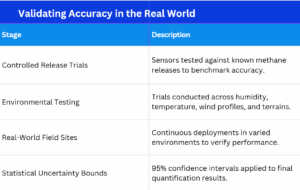
Field-Proven Performance
Our real-world uncertainty performance is validated by measured results, not estimates.
In complex offshore environments, like bp’s Clair Phase 1 facility, our drone-mounted methane spectrometer measured emissions within ±20% of known release rates, with detection sensitivity down to 2.5 kg/h, even from 500 m away (Smith et al., 2021; Tavner et al., 2021).
Independent studies at landfills and oilfields show our measurements closely match actual emissions, with agreement between platforms within 10–15% (Hossian et al., 2024; Corbett & Smith, 2022).
These results give operators the confidence that reported values reflect real conditions as opposed to modelled assumptions, enabling more reliable regulatory reporting and verification.
Transparency in Reporting
SeekOps integrates uncertainty bounds directly into reports and dashboards, whether through emission rate ranges (e.g., “12.4 ± 3.1 kg/h”), confidence classification for each source, documentation of assumptions and environmental conditions, or repeatability scoring across revisits or campaigns.
This transparency is essential for high-integrity emissions inventories and meets emerging global standards for ESG and methane reporting like OGMP 2.0 or the new EU Methane Regulation.
Reducing Uncertainty Over Time
Our measurement platform improves with every flight.
As we collect more field data, refine our models, and adjust flight strategies based on terrain and weather, we continually reduce our uncertainty margins, giving customers increasing confidence in our results.
We do it with the use of site-specific wind profiles from on-site anemometers, adaptive flight patterns to capture full plume geometry, real-time quality control during flight operations, and machine learning models to predict and minimize measurement error in complex environments.
Toward a More Confident Climate Future
As the world moves toward net-zero goals and increasingly rigorous climate disclosure frameworks, uncertainty isn’t a liability: it’s a strength.
By quantifying uncertainty, SeekOps empowers operators to prioritize mitigation based on both scale and confidence, communicate transparently with regulators and the public, and build robust emissions inventories that stand up to scrutiny.
Because in the end, reducing emissions isn’t just about knowing there’s a leak, it’s about knowing how much, how sure, and what to do next.
Stay tuned for the next post in our series: “Drone Deployment and Site Mapping – Smarter Surveys Start from the Sky.” And look out for our blog post covering dynamic uncertainty in the coming weeks!
Want to learn how SeekOps quantifies uncertainty and improves confidence in your methane data?
Ask us about our uncertainty and speak with an expert today
Image Credits
Figure 1 from Pérez-Díaz, L., Best, J., Gómez-Martín, F., Hodgson, D., Lang, A., Mather, A., McCarthy, D., & Thorpe, R. (2020). Introduction: Handling uncertainty in the geosciences: identification, mitigation and communication. Solid Earth, 11, 889–897. https://doi.org/10.5194/se-11-889-2020 — Licensed under CC BY 4.0.
References
Corbett, A., & Smith, B. (2022). Study of a Miniature TDLAS System Onboard Two Unmanned Aircraft to Independently Quantify Methane Emissions from Oil and Gas Production Assets and Other Industrial Emitters. Atmosphere, 13(5), 804. https://doi.org/10.3390/atmos13050804
Dawson, K. W., Smith, B. J., Stocker, I., & Evans, P. (2024). Assessing the Application of Drone TDLAS Methane Emissions Monitoring Technology in the Intertropical Convergence Zone Using Machine Learning. APOGCE 2024. https://doi.org/10.2118/221317-MS
Gully-Santiago, M. A., Smith, B., Frederick, T., Dawson, K., & Elliott, D. (2025). Results and Learnings from the TADI 2024 Methane Quantification Trial. SPE Europe Energy Conference and Exhibition. https://doi.org/10.2118/225634-MS
Hossian, R. I., et al. (2024). A Controlled Release Experiment for Investigating Methane Measurement Performance at Landfills. Environmental Research and Education Foundation (EREF). https://erefdn.org/eref-funded-study-highlights-advances-in-measuring-landfill-methane-emissions
Mohammadloo, T. H., Jones, M., Van De Kerkhof, B., Dawson, K., Smith, B. J., Conley, S., et al. (2025). Quantitative estimate of sources of uncertainty in drone-based methane emission measurements. Atmospheric Measurement Techniques, 18, 1301–1325. https://doi.org/10.5194/amt-18-1301-2025
Ravikumar, A. P., Sreedhara, S., Wang, J., et al. (2019). Single-blind inter-comparison of methane detection technologies – results from the Stanford/EDF Mobile Monitoring Challenge. Elementa: Science of the Anthropocene, 7(1), 37. https://doi.org/10.1525/elementa.373
Smith, B. J., Buckingham, S., Touzel, D., et al. (2021). Development of Methods for Top-Down Methane Emission Measurements of Oil and Gas Facilities in an Offshore Environment Using a Miniature Methane Spectrometer and Long-Endurance UAS. SPE Annual Technical Conference and Exhibition. https://doi.org/10.2118/206181-MS
Tavner, C. A., Touzel, D. F., & Smith, B. J. (2021). Application of Long Endurance UAS for Top-Down Methane Emission Measurements of Oil and Gas Facilities in an Offshore Environment. SPE Offshore Europe Conference and Exhibition. https://doi.org/10.2118/205467-MS
